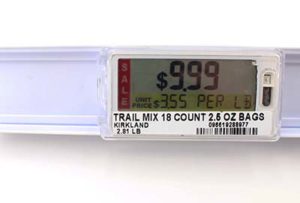Is the Time Right for Electronic Shelf Labels?
Electronic shelf labels (ESLs) have been around for close to 30 years, and it would probably be hard to find an electronic retail product that has generated less stir. But thanks to the pandemic and the resulting great resignation, their time might have come.
Let’s face it. There’s no other retail task as tedious and time-consuming as pricing or changing prices on hundreds or thousands of items. However, with the proper technology – electronic shelf labels – a store owner or manager can change prices on their entire stock in minutes without leaving their computer terminal.

Electronic evolution
Electronic shelf labels made their debut in grocery stores in the United Kingdom. At the time, were hailed as the next big thing in retail. No more need for price tags and the endless task of placing them on every shelf.
The liquid crystal display numbers looked very similar to the early digital clocks or calculators. They did little more than show the price or price per pound. Product descriptions were often on printed labels placed next to the LCDs. Early LCDs had difficulty displaying some letters or symbols. They were expensive and their range, speed, battery life, and reliability weren’t great.
Electronic paper (E-paper) came next. It provided a display that simulated the appearance of ordinary ink on white paper. This rendition featured color ink but suffered from a low data rate that made it hard to display certain images.
The latest generation of ESLs use the same e-paper technology but can display digital color images, provide electronic surveillance and inventory control. Some can also count shoppers who might be viewing the products much like a heat map on a computer screen.
However, like any new technology, the cost of adopting it drastically limited its use. While corporations or large multistore companies could justify the six-figure price tag of putting it into play, most smaller businesses have stuck with paper and ink shelf tags or labels.
Digital divide
There’s no disputing the effectiveness and efficiency of using electronic shelf labels.
Price accuracy
Because they’re all wirelessly plugged into a base station and computer, prices are always up to date. This prevents mislabeling and relabeling. It also links product pricing through all sales channels – online and in-store. If a customer looks up the price of a product while browsing the internet at home or on a smartphone while they’re standing in a store at the shelf, the price will be consistent. Vusion Group says its SESimagotag ESL system eliminates pricing errors which helps stores reduce customer complaints and government fines.
Shelf edge influence
Technical assistance
Labor savings
Large grocery stores can spend roughly $10 million a year changing prices. There’s also the physical cost savings of not having to buy labels, label guns, and additional shelf tags. Vusion Group claims its electronic shelf label system reduces time spent on pricing updates by 80%.
Perishability management
In the grocery business, expiration dates on products can be difficult to manage. Food retailers throw away approximately $940 billion or 10.5 million tons of expired food annually. Being able to discount products with approaching expiration dates with just a few computer keystrokes can reduce the amount of those products that are trashed. Electronic displays can allow store managers to automatically apply discounts to products approaching their sell-by dates.
Dynamic pricing
The ease at which ESL systems facilitate price changes lends themselves to industries that experience fluctuating markets. Grocery is the most obvious. Many of those products feature sell-by dates which can affect the price. The hospitality and travel industries live on dynamic pricing. Lumber is another industry with rapid price changes. Using ESLs, LBM retailers could easily sell their products at market prices, rather than selling them at a static markup from when it was purchased. Dynamic pricing also makes it easy to create impromptu sales promotions.
Pandemic pricing problems
The pandemic and subsequent labor shortage created more reasons why more retailers might consider using ESLs. Supply chain issues have resulted in more out-of-stock items and frequent price increases. The Great Resignation also made it hard to find the employees needed to change those prices. The combination of those two issues left stores scrambling to handle routine store functions like pricing. Electronic shelf labels provided some relief for stores that were equipped with them.
The Pricer survey included data from more than 1,000 stores that remained open during the pandemic – groceries, hardware, pharmacies, liquor stores, electronics and automotive stores. It found that of the two-thirds of those stores that used ESLs 66% said it would have been difficult to manage without them. Also, 92% thought ESLs were essential in dealing with the problems created by the pandemic. ESL manufacturers claim their products reduce this labor cost by 90%.
 Added e-perks
Added e-perks
ESLs can also help with inventory management, improve efficiency in buy online pickup in-store (BOPIS) and curbside pickup programs, and consumer tracking. Some electronic label systems feature applications that help customers find the products they’re looking for on a store’s shelves via an electronic finder. This application can also be used by store employees who fulfill online orders.
ESLs that are connected to a store’s point-of-sale system can track inventory on shelves and display when dates when items are expected to be restocked. These systems can also be equipped with devices that track the movements of customers throughout a store, much like a heat map applied to web pages.
Cost of doing e-labels
The key reason electronic shelf labels took so long to catch on is the price. At $6 a label, and that’s probably on the low end, a store with 20,000 items on its shelves would cost a cool $120,000 to $200,000. And that’s just for the labels. A gateway, which updates the labels, runs from $300 to $400. Those gateways will control from 1,000 to 3,000 labels so that stores with 20,000 items could add another $2,400 or more. ESL management software tacks on another $500.
Truno, a retail technology provider, says a 30,000-tag system can cost nearly $350,000. But if properly utilized can pay for itself in two to three years. Other manufacturers claim a return on investment can be achieved anywhere from 18 months to two and a half years.
Upshot
ESLs have been around long enough to prove their effectiveness and versatility. Like any innovative technology, they have evolved and improved over the years. Paladin Point of Sale integrates with the ses-imagotag system from VusionGroup.
Their price tag still gives small, independent businesses pause. But with employees in short supply, prices rising and falling like the tide, and the investment of the systems scalable, ESLs might be worth considering as a long-term investment for any business.
brian bullock
Author



What is the cost from Paladin for tags.
We would love to provide you with more information about Paladin features and products. If you are a current Paladin customer your account rep can help answer any questions. If you’re not a Paladin customer, please reach out to speak with a Paladin representative at 800-725-2346 and press 1 for Sales.